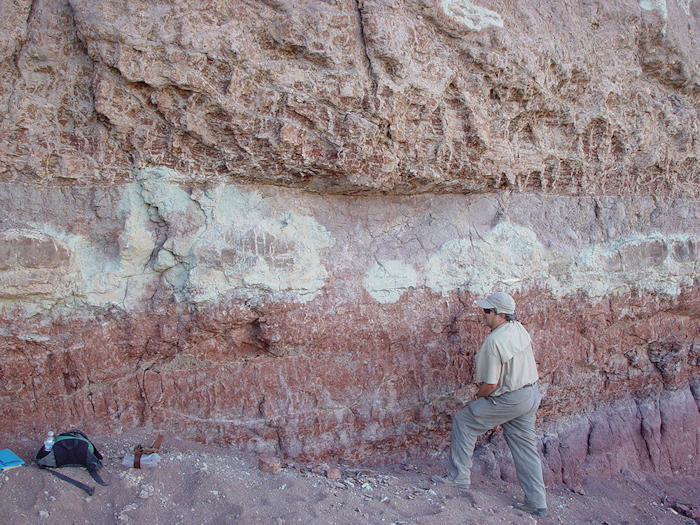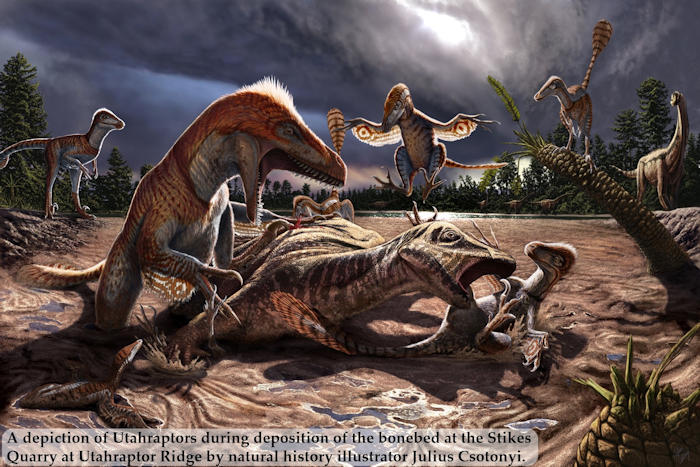Eddie Gonzales Jr. – AncientPages.com – Utahraptor is going to need 10 million more candles on its next birthday cake.
A geological study of the rock formation that encased a fossilized example of the world’s biggest “raptor” shows it’s 10 million years older than previously understood. The report, co-written by a researcher with the University of Kansas, recently appeared in the journal Geosciences.

Greg Ludvigson on outcrop of colorful buried soils of the Yellow Cat Member in May 2009. Credit: Matt Joeckel
“We determined the age of the dinosaur Utahraptor and found that it was much older than previously supposed,” said Gregory Ludvigson, emeritus senior scientist with the Kansas Geological Survey at KU, who collaborated on the investigation. “That finding has important implications for the evolutionary history of dinosaurs.”
The fieldwork took place in Utah at the well-known Utahraptor Ridge site, named for larger cousins of the ferocious velociraptor dinosaur (known to fans of “Jurᴀssic Park”).
The ridge is home to Stikes Quarry, a fossil quicksand deposit packed with dinosaur fossils that are largely intact and preserved—in much the same positions as when they died. Stikes Quarry is part of the Cedar Mountain Formation, a rock unit containing fossils of more kinds of dinosaurs than any formation in the world.
“We also learned to our complete surprise that the rock strata from the Stikes Dinosaur Quarry were deposited during a global change episode known as the Weissert Event,” Ludvigson said. “This is an agenda-setting discovery that will reverberate for decades.”
More than a decade ago, Ludvigson, along with Jim Kirkland, state paleontologist with the Utah Geological Survey, and Matt Joeckel, state geologist and director of the Conservation and Survey Division at the University of Nebraska-Lincoln, joined together to tackle that question.
The scientists and colleagues they recruited took two research approaches: One path—uranium/lead dating of zircon crystals—involved analyzing samples of these minerals collected at different depths in the rock layers. The second looked at changes in the relative abundance of two types of stable carbon isotopes found in buried organic matter.
By comparing results to periods in Earth’s history when global changes in the carbon cycle were known to have occurred, the team showed rocks in the Yellow Cat Member of the Cedar Mountain Formation—and the Utahraptor fossils found within—are 10 million years older than previously known.
Earlier estimates put the age of the rocks and fossils at 125 million years old.
“That’s a lot of evolutionary time,” Ludvigson said. “It’s kind of a vindication of something Jim’s argued for some time, but arguing doesn’t put an absolute age on it, and that’s important to him.”

Image source: Geosciences
The revised age indicates the rocks at the Stikes Quarry are at least 135 million years old. The lower part of the Yellow Cat Member encompᴀsses even older strata. The findings narrow the gap in the rock record at the boundary between the Jurᴀssic and Cretaceous Periods in Utah.
“Before, we had a 25-million-year gap between them,” said Kirkland, who first named and described the dinosaur Utahraptor ostrommaysi in 1993. “That’s a third of the age of mammals, more than double the length of time for hominid evolution. It’s a big chunk of time. Anything can happen over 25 million years if you have no record of what’s going on. We’ve plugged that record, for the most part.”
The work is published in the journal Geosciences.
Written by Eddie Gonzales Jr. – AncientPages.com – MessageToEagle.com Staff





